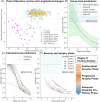Trajectories of Pontine Volume in Patients with Multiple System Atrophy
- PMID: 40172076
- PMCID: PMC12273624
- DOI: 10.1002/mds.30182
Trajectories of Pontine Volume in Patients with Multiple System Atrophy
Abstract
Objectives: To investigate trajectories of regional brain volume changes in multiple system atrophy (MSA) and their potential utility as surrogate markers of disease progression in the cerebellar subtype (MSA-C).
Background: Reliable biomarkers for tracking disease progression in MSA are urgently needed. Although several studies have explored neuroimaging markers, imaging measures that are reliable and reproducible at the individual-level are lacking.
Methods: Longitudinal three-dimensional (3D)-T1 images from multiple cohorts of 21 subjects with probable MSA-C, 19 with probable MSA-parkinsonian subtype (MSA-P), 113 with Parkinson's disease, and 227 healthy controls were processed using the FreeSurfer longitudinal pipeline. Extracted volumes were assessed for individual longitudinal trajectories, intra-individual variability, and pontine regional volume decline.
Results: Pontine volumes showed lower intra-individual variability in measurements compared with other infratentorial brain regions. All probable MSA-C patients exhibited a decline in pontine volume, ranging from -3.6% to -16.8% per year (mean: -9.1%), falling more than two standard deviations below the mean of healthy controls. In MSA-C, the temporal dynamics of pontine volumes exhibited nonlinear changes, characterized by progressive atrophy in the earlier period of the disease, followed by a pre-plateau phase associated with advanced disability in the later period. Predictive modeling suggests that pontine atrophy may begin before symptom onset of MSA-C.
Conclusions: Pontine volume is a sensitive marker of disease progression, exhibiting a nonlinear decline with low intra-individual variability in measurements and greater volume loss in the earlier stages, reaching a pre-plateau phase in the later stages with advanced disability. © 2025 The Author(s). Movement Disorders published by Wiley Periodicals LLC on behalf of International Parkinson and Movement Disorder Society.
© 2025 The Author(s). Movement Disorders published by Wiley Periodicals LLC on behalf of International Parkinson and Movement Disorder Society.
Figures


Similar articles
-
White Matter Abnormalities Track Disease Progression in Multiple System Atrophy.Mov Disord Clin Pract. 2024 Sep;11(9):1085-1094. doi: 10.1002/mdc3.14147. Epub 2024 Jun 24. Mov Disord Clin Pract. 2024. PMID: 38923361 Free PMC article.
-
Chronic urinary tract infections cause persistent microglial changes in a humanized ɑ-synuclein mouse model.J Parkinsons Dis. 2024 Nov;14(8):1559-1574. doi: 10.1177/1877718X241289046. Epub 2024 Dec 27. J Parkinsons Dis. 2024. PMID: 39957188
-
The Movement Disorder Society Criteria for the Diagnosis of Multiple System Atrophy.Mov Disord. 2022 Jun;37(6):1131-1148. doi: 10.1002/mds.29005. Epub 2022 Apr 21. Mov Disord. 2022. PMID: 35445419 Free PMC article.
-
Diffuse putaminal degeneration without iron deposition in multiple system atrophy.J Parkinsons Dis. 2025 Aug;15(5):1019-1023. doi: 10.1177/1877718X251355592. Epub 2025 Jul 6. J Parkinsons Dis. 2025. PMID: 40619876
-
The Black Book of Psychotropic Dosing and Monitoring.Psychopharmacol Bull. 2024 Jul 8;54(3):8-59. Psychopharmacol Bull. 2024. PMID: 38993656 Free PMC article. Review.
Cited by
-
The role of neuro-imaging in multiple system atrophy.J Neural Transm (Vienna). 2025 Jul 12. doi: 10.1007/s00702-025-02964-6. Online ahead of print. J Neural Transm (Vienna). 2025. PMID: 40650740 Review.
References
-
- Heim B, Krismer F, Poewe W, Seppi K. Imaging markers of disease progression in multiple system atrophy. Future Neurol 2019;14(3):FNL24. 10.2217/fnl-2018-0045 - DOI
MeSH terms
Grants and funding
LinkOut - more resources
Full Text Sources

